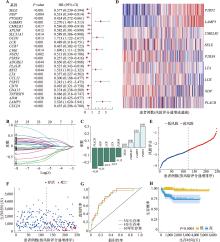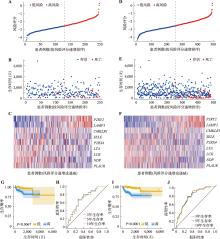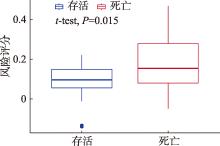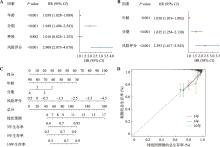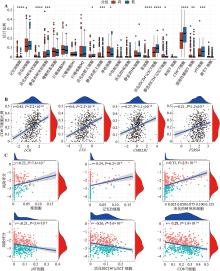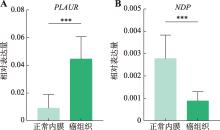Hereditas(Beijing) ›› 2025, Vol. 47 ›› Issue (9): 1007-1022.doi: 10.16288/j.yczz.24-376
• Research Article • Previous Articles Next Articles
A prognostic risk model construction for endometrial cancer based on inflammation-related genes
Jianyao Liu1( ), Yue Li1, Huanhuan Hu2, Shuyue Xiao2, Xinyi Xie2, Shanliang Zhong1, Zhen Gong2, Chenjing Zhu1, Hanzi Xu1(
), Yue Li1, Huanhuan Hu2, Shuyue Xiao2, Xinyi Xie2, Shanliang Zhong1, Zhen Gong2, Chenjing Zhu1, Hanzi Xu1( )
)
- 1. The Affiliated Cancer Hospital of Nanjing Medical University, Jiangsu Cancer Hospital, Jiangsu Institute of Cancer Research, Nanjing 210009, China
2. Women's Hospital of Nanjing Medical University, Nanjing Women and Children’s Healthcare Hospital, Nanjing 210004, China
-
Received:2025-02-08Revised:2025-06-05Online:2025-06-06Published:2025-06-06 -
Contact:Hanzi Xu E-mail:ly24_00@163.com;xuhanzi@njmu.edu.cn -
Supported by:National Natural Science Foundation of China(82102850);Wu Jieping Medical Foundation Special Fund for Clinical Research(320.6750.2023.17-1);Natural Science Foundation of Jiangsu Province, China(BK20241993);Key Medical Research Project of Jiangsu Provincial Health Commission(2024-36)
Cite this article
Jianyao Liu, Yue Li, Huanhuan Hu, Shuyue Xiao, Xinyi Xie, Shanliang Zhong, Zhen Gong, Chenjing Zhu, Hanzi Xu. A prognostic risk model construction for endometrial cancer based on inflammation-related genes[J]. Hereditas(Beijing), 2025, 47(9): 1007-1022.
share this article
Add to citation manager EndNote|Reference Manager|ProCite|BibTeX|RefWorks
Table 1
Characteristics of endometrial cancer patients in TCGA-UCEC"
| 参数 | 所有患者 (n=496) | 训练集 (n=248) | 测试集 (n=248) | P 值 | |
|---|---|---|---|---|---|
| 年龄 | 63.71 ± 10.97 | 64.15 ± 10.82 | 63.28 ± 11.12 | 0.38 | |
| ≤65 岁 | 286 (57.66) | 143 (57.66) | 143 (57.66) | 1.00 | |
| >65 岁 | 210 (42.34) | 105 (42.34) | 105 (42.34) | ||
| 种族 | 白种人 | 337 (67.94) | 174 (70.16) | 163 (65.73) | 0.29 |
| 其他 | 159 (32.06) | 74 (29.84) | 85 (34.27) | ||
| 分期 | I | 319 (65.37) | 158 (65.02) | 161 (65.71) | 0.25 |
| II | 49 (10.04) | 30 (12.35) | 19 (7.76) | ||
| III | 106 (21.72) | 47 (19.34) | 59 (24.08) | ||
| IV | 14 (2.87) | 8 (3.29) | 6 (2.45) | ||
| 生存状态 | 存活 | 451 (90.73) | 223 (89.92) | 228 (91.94) | 0.43 |
| 死亡 | 45 (9.07) | 25 (10.08) | 20 (8.06) | ||
| 生存时间 (天) | 1,128.94 ±919.02 | 1,142.05 ± 930.97 | 1,115.83 ± 908.61 | 0.75 | |
| [1] |
Bray F, Laversanne M, Sung H, Ferlay J, Siegel RL, Soerjomataram I, Jemal A. Global cancer statistics 2022: GLOBOCAN estimates of incidence and mortality worldwide for 36 cancers in 185 countries. CA Cancer J Clin, 2024, 74(3): 229-263.
pmid: 38572751 |
| [2] |
Gentry-Maharaj A, Karpinskyj C. Current and future approaches to screening for endometrial cancer. Best Pract Res Clin Obstet Gynaecol, 2020, 65: 79-97.
pmid: 32205051 |
| [3] |
Weiderpass E, Antoine J, Bray FI, Oh JK, Arbyn M. Trends in corpus uteri cancer mortality in member states of the European Union. Eur J Cancer, 2014, 50(9): 1675-1684.
pmid: 24656568 |
| [4] |
Diakos CI, Charles KA, McMillan DC, Clarke SJ. Cancer-related inflammation and treatment effectiveness. Lancet Oncol, 2014, 15(11): e493-e503.
pmid: 25281468 |
| [5] |
Yu GC, Wang LG, Han YY, He QY. clusterProfiler: an R package for comparing biological themes among gene clusters. OMICS, 2012, 16(5): 284-287.
pmid: 22455463 |
| [6] |
Zhou ZR, Wang WW, Li Y, Jin KR, Wang XY, Wang ZW, Chen YS, Wang SJ, Hu J, Zhang HN, Huang P, Zhao GZ, Chen XX, Li B, Zhang TS. In-depth mining of clinical data: the construction of clinical prediction model with R. Ann Transl Med, 2019, 7(23): 796.
pmid: 32042812 |
| [7] |
Hu FF, Liu CJ, Liu LL, Zhang Q, Guo AY. Expression profile of immune checkpoint genes and their roles in predicting immunotherapy response. Brief Bioinform, 2021, 22(3): bbaa176.
pmid: 32814346 |
| [8] |
Maeser D, Gruener RF, Huang RS. oncoPredict: an R package for predicting in vivo or cancer patient drug response and biomarkers from cell line screening data. Brief Bioinform, 2021, 22(6): bbab260.
pmid: 34260682 |
| [9] |
Makker V, MacKay H, Ray-Coquard I, Levine DA, Westin SN, Aoki D, Oaknin A. Endometrial cancer. Nat Rev Dis Primers, 2021, 7(1): 88.
pmid: 34887451 |
| [10] |
Siegel RL, Kratzer TB, Giaquinto AN, Sung H, Jemal A. Cancer statistics, 2025. CA Cancer J Clin, 2025, 75(1): 10-45.
pmid: 39817679 |
| [11] |
Thrastardottir TO, Copeland VJ, Constantinou C. The association between nutrition, obesity, inflammation, and endometrial cancer: a scoping review. Curr Nutr Rep, 2023, 12(1): 98-121.
pmid: 36513957 |
| [12] |
Hu LP, Zhang XX, Jiang SH, Tao LY, Li Q, Zhu LL, Yang MW, Huo YM, Jiang YS, Tian GA, Cao XY, Zhang YL, Yang Q, Yang XM, Wang YH, Li J, Xiao GG, Sun YW, Zhang ZG. Targeting purinergic receptor P2Y2 prevents the growth of pancreatic ductal adenocarcinoma by inhibiting cancer cell glycolysis. Clin Cancer Res, 2019, 25(4): 1318-1330.
pmid: 30420446 |
| [13] |
Katzur AC, Koshimizu T, Tomić M, Schultze-Mosgau A, Ortmann Q, Stojilkovic SS. Expression and responsiveness of P2Y2 receptors in human endometrial cancer cell lines. J Clin Endocrinol Metab, 1999, 84(11): 4085-4091.
pmid: 10566654 |
| [14] |
Dong CR, Hu DX, Liu SC, Luo HL, Zhang WJ. AKT/GSK-3beta/VEGF signaling is involved in P2RY2 activation-induced the proliferation and metastasis of gastric cancer. Carcinogenesis, 2023, 44(1): 65-79.
pmid: 36469496 |
| [15] |
Fu BD, Zhou MQ, Geng XT, Jiang YK, Zeng H, Zhou XR, Yu ZC, Pan JY, Zhu YT, Zheng H, Huang SH, Gong YY, Huang D, Zhong YY. LAMP3 is a potent uterine corpus endometrial carcinoma prognostic biomarker associated with immune behavior. Aging (Albany NY), 2024, 16(1): 714-745.
pmid: 38217544 |
| [16] |
Wang D, Cao XM, Zhang YQ, Liu YL, Yao C, Ge WL, Xu YZ. LAMP3 expression correlated with poor clinical outcome in human ovarian cancer. Tumour Biol, 2017, 39(3): 1010428317695014.
pmid: 28349821 |
| [17] |
Mohajertehran F, Mohtasham N, Ahmadi M, Shahabinejad M, Mohammadi M. RT-qPCR analysis of LAMP3 (CD208) gene expression in oral lichen planus and oral squamous cell carcinoma. Rep Biochem Mol Biol, 2023, 12(1): 36-41.
pmid: 37724152 |
| [18] | Yu GY, Dai XY, Zhang J, Li QX, Cao GS, Jin P. Impact of CMKLR1 on migration and proliferation properties of endometrial carcinoma cell line HEC-1-B. Prog Obstet Gynecol, 2018, 27(7): 512-517. |
| 余贵媛, 代小勇, 张键, 李秋霞, 曹冠姝, 金平. CMKLR1对子宫内膜癌细胞增殖和迁移特性的影响. 现代妇产科进展, 2018, 27(7): 512-517. | |
| [19] |
Zakariya BF, Almohaidi AMS, Şimşek SA, Al-Waysi SA, Al-Dabbagh WH, Kamal AM. The relationship of E-selectin singlenucleotide polymorphisms with breast cancer in Iraqi Arab women. Genomics Inform, 2022, 20(4): e42.
pmid: 36617649 |
| [20] |
Colas E, Perez C, Cabrera S, Pedrola N, Monge M, Castellvi J, Eyzaguirre F, Gregorio J, Ruiz A, Llaurado M, Rigau M, Garcia M, Ertekin T, Montes M, Lopez-Lopez R, Carreras R, Xercavins J, Ortega A, Maes T, Rosell E, Doll A, Abal M, Reventos J, Gil-Moreno A. Molecular markers of endometrial carcinoma detected in uterine aspirates. Int J Cancer, 2011, 129(10): 2435-2444.
pmid: 21207424 |
| [21] |
Schmitt M, Ceteci F, Gupta J, Pesic M, Böttger TW, Nicolas AM, Kennel KB, Engel E, Schewe M, Kirisözü AC, Petrocelli V, Dabiri Y, Varga J, Ramakrishnan M, Karimova M, Ablasser A, Sato T, Arkan MC, de Sauvage FJ, Greten FR. Colon tumour cell death causes mTOR dependence by paracrine P2X4 stimulation. Nature, 2022, 612(7939): 347-353.
pmid: 36385525 |
| [22] |
Cheng SS, Li JZ, Liu WJ, Liu CX, Su L, Liu XC, Guo LJ, Ma Y, Song B, Liu J. LTA + 252A > G polymorphism is associated with risk of nasal NK/T-cell lymphoma in a Chinese population: a case-control study. BMC Cancer, 2015, 15: 480.
pmid: 26108796 |
| [23] |
Li JD, Wang YX, Chang XL, Han ZW. The effect of LTA gene polymorphisms on cancer risk: an updated systematic review and meta-analysis. Biosci Rep, 2020, 40(5): BSR20192320.
pmid: 32420584 |
| [24] |
Bandil K, Singhal P, Sharma U, Hussain S, Basu S, Parashari A, Singh V, Sehgal A, Shivam A, Ahuja P, Bharadwaj M, Dev Banerjee B, Mehrotra R. Impacts of TNF-LTA SNPs/haplotypes and lifestyle factors on oral carcinoma in an Indian population. Mol Diagn Ther, 2016, 20(5): 469-480.
pmid: 27312561 |
| [25] | Dai P, Liu X, Li QW. Function of the Lck and Fyn in T cell development. Hereditas(Beijing), 2012, 34(3): 289-295. |
| 戴鹏, 刘欣, 李庆伟. Lck和Fyn对T细胞发育过程的影响. 遗传, 2012, 34(3): 289-295. | |
| [26] |
Gulati P, Rühl J, Kannan A, Pircher M, Schuberth P, Nytko KJ, Pruschy M, Sulser S, Haefner M, Jensen S, Soltermann A, Jungraithmayr W, Eisenring M, Winder T, Samaras P, Tabor A, Stenger R, Stupp R, Weder W, Renner C, Münz C, Petrausch U. Aberrant lck signal via CD28 costimulation augments antigen-specific functionality and tumor control by redirected T cells with PD-1 blockade in humanized mice. Clin Cancer Res, 2018, 24(16): 3981-3993.
pmid: 29748183 |
| [27] |
Saygin C, Wiechert A, Rao VS, Alluri R, Connor E, Thiagarajan PS, Hale JS, Li Y, Chumakova A, Jarrar A, Parker Y, Lindner DJ, Nagaraj AB, Kim JJ, DiFeo A, Abdul-Karim FW, Michener C, Rose PG, DeBernardo R, Mahdi H, McCrae KR, Lin F, Lathia JD, Reizes O. CD55 regulates self-renewal and cisplatin resistance in endometrioid tumors. J Exp Med, 2017, 214(9): 2715-2732.
pmid: 28838952 |
| [28] |
El-Sehemy A, Selvadurai H, Ortin-Martinez A, Pokrajac N, Mamatjan Y, Tachibana N, Rowland K, Lee L, Park N, Aldape K, Dirks P, Wallace VA. Norrin mediates tumor- promoting and suppressive effects in glioblastoma via Notch and Wnt. J Clin Invest, 2020, 130(6): 3069-3086.
pmid: 32182224 |
| [29] |
Foca C, Moses EK, Quinn MA, Rice GE. Differential mRNA expression of urokinase-type plasminogen activator, plasminogen activator receptor and plasminogen activator inhibitor type-2 in normal human endometria and endometrial carcinomas. Gynecol Oncol, 2000, 79(2): 244-250.
pmid: 11063652 |
| [30] |
Zhang T, Wang BF, Su F, Gu BH, Xiang L, Gao L, Zheng P, Li XM, Chen H. TCF7L2 promotes anoikis resistance and metastasis of gastric cancer by transcriptionally activating PLAUR. Int J Biol Sci, 2022, 18(11): 4560-4577.
pmid: 35864968 |
| [31] |
Zhang YY, Zhang ZM. The history and advances in cancer immunotherapy: understanding the characteristics of tumor-infiltrating immune cells and their therapeutic implications. Cell Mol Immunol, 2020, 17(8): 807-821.
pmid: 32612154 |
| [32] | Wan YX, Zhu XY, Zhao Y, Sun N, Jiang TTF, Xu J. Computational dissection of the regulatory mechanisms of aberrant metabolism in remodeling the microenvironment of breast cancer. Hereditas(Beijing), 2024, 46(10): 871-885. |
| 万羽鑫, 朱欣雨, 赵宇, 孙娜, 江天彤妃, 徐娟. 计算解析异常代谢对乳腺癌微环境重塑的调控机制. 遗传, 2024, 46(10): 871-885. | |
| [33] |
Fridman WH, Pagès F, Sautès-Fridman C, Galon J. The immune contexture in human tumours: impact on clinical outcome. Nat Rev Cancer, 2012, 12(4): 298-306.
pmid: 22419253 |
| [34] |
Horeweg N, de Bruyn M, Nout RA, Stelloo E, Kedziersza K, León-Castillo A, Plat A, Mertz KD, Osse M, Jürgenliemk-Schulz IM, Lutgens LCHW, Jobsen JJ, van der Steen-Banasik EM, Smit VT, Creutzberg CL, Bosse T, Nijman HW, Koelzer VH, Church DN. Prognostic integrated image-based immune and molecular profiling in early-stage endometrial cancer. Cancer Immunol Res, 2020, 8(12): 1508-1519.
pmid: 32999003 |
| [35] |
Abu-Rustum N, Yashar C, Arend R, Barber E, Bradley K, Brooks R, Campos SM, Chino J, Chon HS, Chu C, Crispens MA, Damast S, Fisher CM, Frederick P, Gaffney DK, Giuntoli R, Han E, Holmes J, Howitt BE, Lea J, Mariani A, Mutch D, Nagel C, Nekhlyudov L, Podoll M, Salani R, Schorge J, Siedel J, Sisodia R, Soliman P, Ueda S, Urban R, Wethington SL, Wyse E, Zanotti K, McMillian NR, Aggarwal S. Uterine neoplasms, version 1.2023, NCCN clinical practice guidelines in oncology. J Natl Compr Canc Netw, 2023, 21(2): 181-209.
pmid: 36791750 |
| [1] | Yanni Kou, Shan Cen, Xiaoyu Li. Research and application on LINE-1 in diagnosis and treatment of tumorigenesis [J]. Hereditas(Beijing), 2021, 43(6): 571-579. |
| [2] | LIN De-Chen, SHI Zhi-Zhou, XUE Li-Yan, CHEN Wei, XU Cuan, HAN E-Ling, LV Ning, WANG Meng-Rong. Expression of cell cycle related proteins cyclin D1, p53 and p21 in esophageal squamous cell carcinoma [J]. HEREDITAS, 2010, 32(5): 455-460. |
| Viewed | ||||||
|
Full text |
|
|||||
|
Abstract |
|
|||||






